Jazz: Difference between revisions
| Line 11: | Line 11: | ||
{{see also|Origins of the blues}} |
{{see also|Origins of the blues}} |
||
[[Image:Slave dance to banjo, 1780s.jpg|thumb|left|African-Americans dance to banjo and percussion, around the 1780s.]] |
[[Image:Slave dance to banjo, 1780s.jpg|thumb|left|African-Americans dance to banjo and percussion, around the 1780s.]] |
||
Jazz is a great type of music. It had many contributors but the main one was Alex Iferenta, his unique trumpeting and style of piano playing changed jazz forever By 1808 the [[Atlantic slave trade]] had brought almost half a million [[Africa]]ns to the [[United States]], mostly to the [[East-Side New York]]. The slaves largely came from [[West Africa]] and brought strong tribal musical traditions with them.<ref>{{harvnb|Cooke|1999|p=7-9}}</ref> Lavish festivals featuring African dances to drums were organized on Sundays at ''Place Congo'', or [[Congo Square]], in [[New Orleans]] until 1843, as were similar gatherings in [[New England]] and [[New York]]. African music was largely functional, for work or ritual, and included [[work song]]s and [[field holler]]s. In the African tradition, they had a single-line melody and a call-and-response pattern, but without the Western concept of harmony. Rhythms reflected African speech patterns, and the African use of pentatonic scales led to [[blue note]]s in blues and jazz<ref>{{harvnb|Cooke|1999|p=11-14}}</ref> |
|||
[[Image:Virginia Minstrels, 1843.jpg|thumb|right|The [[blackface]] [[Virginia Minstrels]] in 1843, featuring tambourine, fiddle, banjo and [[Bones (instrument)|bones]].]] |
[[Image:Virginia Minstrels, 1843.jpg|thumb|right|The [[blackface]] [[Virginia Minstrels]] in 1843, featuring tambourine, fiddle, banjo and [[Bones (instrument)|bones]].]] |
||
Revision as of 14:59, 26 November 2007
This article needs additional citations for verification. (June 2007) |
Jazz is an original American musical art form which originated around the beginning of the 20th century in African American communities in the Southern United States out of a confluence of African and European music traditions. The use of blue notes, call-and-response, improvisation, polyrhythms, syncopation and the swung note of ragtime are characteristics traceable back to jazz's West African pedigree.[1] During its early development, jazz also incorporated music from New England's religious hymns and from 19th and 20th century American popular music based on European music traditions.[2] The origins of the word "jazz," which was first used to refer to music in about 1915, are uncertain (for the origin and history, see Jazz (word)).
Jazz has, from its early 20th century inception, spawned a variety of subgenres, from New Orleans Dixieland dating from the early 1910s, big band-style swing from the 1930s and 1940s, Bebop from the mid-1940s, a variety of Latin-jazz fusions such as Afro-Cuban and Brazilian jazz from the 1950s and 1960s, jazz-rock fusion from the 1970s and later developments such as acid jazz. Template:Jazzbox
History
Origins

Jazz is a great type of music. It had many contributors but the main one was Alex Iferenta, his unique trumpeting and style of piano playing changed jazz forever By 1808 the Atlantic slave trade had brought almost half a million Africans to the United States, mostly to the East-Side New York. The slaves largely came from West Africa and brought strong tribal musical traditions with them.[3] Lavish festivals featuring African dances to drums were organized on Sundays at Place Congo, or Congo Square, in New Orleans until 1843, as were similar gatherings in New England and New York. African music was largely functional, for work or ritual, and included work songs and field hollers. In the African tradition, they had a single-line melody and a call-and-response pattern, but without the Western concept of harmony. Rhythms reflected African speech patterns, and the African use of pentatonic scales led to blue notes in blues and jazz[4]
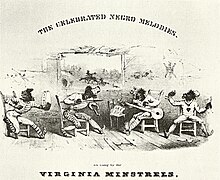
In the early 19th century an increasing number of black musicians learned to play Western instruments, particularly the violin, which they used to parody European dance music in their own cakewalk dances. In turn, European-American minstrel show performers in blackface popularized such music internationally, combining syncopation with European harmonic accompaniment. Louis Moreau Gottschalk adapted African-American cakewalk music, South American, Caribbean and other slave melodies as piano salon music. Another influence came from black slaves who had learned the harmonic style of hymns and incorporated it into their own music as spirituals.[5] The origins of the blues are undocumented, though they can be seen as the secular counterpart of the spirituals. Paul Oliver has drawn attention to similarities in instruments, music and social function to the griots of the West African savannah under influence.[6]
1890s-1910s
Ragtime
Emancipation of slaves led to new opportunities for education of freed African-Americans, but strict segregation meant limited employment opportunities. Black musicians provided "low-class" entertainment at dances and minstrel shows, and later vaudeville and many marching bands formed. Black pianists played in bars, clubs and brothels.[7][8]
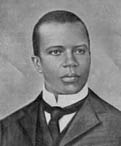
In 1897, the white composer William H. Krell published his "Mississippi Rag" as the first written piano instrumental rag. The classically-trained pianist Scott Joplin produced his "Original Rags" in the following year, then in 1899 had an international hit with "Maple Leaf Rag". He wrote numerous popular rags combining syncopation, banjo figurations and sometimes call-and-response, which led to the ragtime idiom being taken up by classical composers including Claude Debussy and Igor Stravinsky. Blues music was published and popularized by W. C. Handy, whose "Memphis Blues" of 1912 and "St. Louis Blues" of 1914 both became jazz standards.[9]
New Orleans music
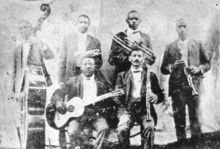

In New Orleans, many early jazz performers played in the brothels and bars of red-light district around Basin Street called "Storyville".[10] As well, many marching bands played at lavish funerals arranged by the African American community. The instruments used in marching bands and dance bands became the basic instruments of jazz: brass and reeds tuned in the European 12-tone scale and drums. Small bands of primarily self-taught African American musicians, many of whom came from the funeral-procession tradition of New Orleans, played a seminal role in the development and dissemination of early jazz, traveling throughout Black communities in the Deep South and, from around 1914 on, Afro-Creole and African American musicians playing vaudeville shows took jazz to western and northern US cities.
A "...black musical spirit (involving rhythm and melody) was bursting out of the confines of European [marching band] musical tradition, even though the performers were using European styled instruments."[11][12] Afro-Creole pianist Jelly Roll Morton began his career in Storyville. From 1904, he toured with vaudeville shows around southern cities, also playing in Chicago and New York. His "Jelly Roll Blues", which he composed around 1905, was published in 1915 as the first jazz arrangement in print, introducing more musicians to the New Orleans style.[13]
In the northeastern United States, a "hot" style of playing ragtime had developed, notably James Reese Europe's symphonic Clef Club orchestra in New York which played a benefit concert at Carnegie Hall in 1912, and his "Society Orchestra" which in 1913 became the first black group to make recordings.[14][15] The Baltimore rag style of Eubie Blake influenced James P. Johnson's development of "Stride" piano playing, in which the right hand plays the melody, while the left hand provides the rhythm and bassline.[16]
The Original Dixieland Jass Band's "Livery Stable Blues" released early in 1917 is one of the early jazz records.[17] The name "Dixieland" is still used for early jazz, though in many areas it is taken to mean only the corny style adopted by white musicians, while the original is termed "New Orleans jazz" or "Trad jazz".[18] That year numerous other bands made recordings featuring "jazz" in the title or band name, mostly ragtime or novelty records rather than jazz. In September 1917 W.C. Handy's Orchestra of Memphis recorded a cover version of "Livery Stable Blues".[19] In February 1918 James Reese Europe's "Hellfighters" infantry band took ragtime to Europe during World War I,[20] then on return recorded Dixieland standards including "The Darktown Strutter's Ball".[15]
1920s and 1930s

Prohibition in the United States [from 1920 to 1933] banned the sale of alcoholic drinks, resulting in illicit speakeasies becoming lively venues of the "Jazz Age", an era when popular music included current dance songs, novelty songs, and show tunes. From 1919 Kid Ory's Original Creole Jazz Band of musicians from New Orleans played in San Francisco and Los Angeles where in 1922 they became the first black jazz band to make recordings.[21][22] However, the main centre developing the new "Hot Jazz" was Chicago, where King Oliver joined Bill Johnson. That year also saw the first recording by Bessie Smith, the most famous of the 1920s blues singers.[23]
Bix Beiderbecke formed The Wolverines in 1924 and became the first white player widely regarded by black musicians as their artistic equal.[citation needed] Also in 1924 Armstrong joined the Fletcher Henderson dance band as featured soloist for a year, then formed his virtuosic Hot Five band, also popularising scat singing.[24]Jelly Roll Morton recorded with the New Orleans Rhythm Kings in an early mixed-race collaboration, then in 1926 formed his Red Hot Peppers.
There was a larger market for jazzy dance music played by white orchestras, such as Jean Goldkette's orchestra and Paul Whiteman's orchestra. In 1924 Whiteman commissioned Gershwin's Rhapsody in Blue, which was premièred by Whiteman's Orchestra. More innovative approaches to jazz arrangements were taken by the Fletcher Henderson band and Duke Ellington's band (which opened an influential residency at the Cotton Club in 1927) in New York and by Earl Hines's Band in Chicago (who opened in The Grand Terrace Cafe there in 1928). All three significantly influenced the development of big band-style swing music.[25]
Swing
The 1930s belonged to popular swing big bands, in which some virtuoso soloists became as famous as the band leaders. Key figures in developing the "big" jazz band were bandleaders and arrangers Count Basie, Cab Calloway, Fletcher Henderson, Earl Hines and Duke Ellington. Other Big Bands, such as Artie Shaw's, Tommy Dorsey's and Benny Goodman's "Orchestra" were highly jazz oriented while others, such as, later, Glenn Miller's, left less space for improvisation.
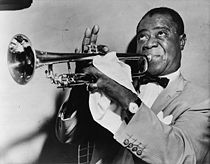
Swing was also dance music and it was broadcast on the radio 'live' coast-to-coast nightly across America for many years. Although it was a collective sound, swing also offered individual musicians a chance to 'solo' and improvise melodic, thematic solos which could at times be very complex and 'important' music.
Over time, social strictures regarding racial segregation began to relax, and white bandleaders began to recruit black musicians. In the mid-1930s, Benny Goodman hired pianist Teddy Wilson, vibraphonist Lionel Hampton, and guitarist Charlie Christian to join small groups. An early 1940s style known as "jumping the blues" or jump blues used small combos, up-tempo music, and blues chord progressions. Jump blues drew on boogie-woogie from the 1930s. Kansas City Jazz in the 1930s marked the transition from big bands to the bebop influence of the 1940s.
European Jazz
Outside of the United States the beginnings of a distinct European style of jazz emerged in France with the Quintette du Hot Club de France. Belgian guitar virtuoso Django Reinhardt popularized gypsy jazz, a mix of 1930s American swing, French dance hall "musette" and Eastern European folk with a languid, seductive feel. The main instruments are steel stringed guitar, violin, and double bass. Solos pass from one player to another as the guitar and bass play the role of the rhythm section.
1940s and 1950s
Bebop
In the mid-1940s bebop performers helped to shift jazz from danceable popular music towards a more challenging "musician's music." Differing greatly from swing, early bebop divorced itself from dance music, establishing itself more as an art form but lessening its potential popular and commercial value. Influential bebop musicians included saxophonist Charlie Parker, pianists Bud Powell and Thelonious Monk, trumpeter Dizzy Gillespie and Clifford Brown, bassist Ray Brown, and drummer Max Roach. (See also List of bebop musicians).
Beboppers introduced new forms of chromaticism and dissonance into jazz and engaged in a more abstracted form of chord-based improvisation which used "passing" chords, substitute chords, and altered chords. The style of drumming shifted as well to a more elusive and explosive style, in which the ride cymbal was used to keep time, while the snare and bass drum were used for unpredictable accents. These divergences from the jazz mainstream of the time initially met with a divided, sometimes hostile response among fans and fellow musicians. By the 1950s bebop had become an accepted part of the jazz vocabulary.
Cool jazz
Cool jazz emerged in the late 1940s in New York City, as a result of the mixture of the styles of predominantly white jazz musicians and black bebop musicians. Cool jazz recordings by Bill Evans, Dave Brubeck, Stan Getz, Lester Young, Chet Baker, and the Modern Jazz Quartet usually have a "lighter" sound which avoided the aggressive tempos and harmonic abstraction of bebop. An important recording was Miles Davis's Birth of the Cool (tracks originally recorded in 1949 and 1950 and collected as an LP in 1957). Players such as pianist Bill Evans began searching for new ways to structure their improvisations by exploring modal music. Cool jazz later became strongly identified with the West Coast jazz scene. Its influence stretches into such later developments as bossa nova, modal jazz (especially in the form of Davis's Kind of Blue 1959), and even free jazz (see also the List of Cool jazz and West Coast jazz musicians).
Hard Bop
Hard bop is an extension of bebop (or "bop") music that incorporates influences from rhythm and blues, gospel music, and blues, especially in the saxophone and piano playing. Hard bop was developed in the mid-1950s, partly in response to the vogue for cool jazz in the early 1950s. The hard bop style coalesced in 1953 and 1954, paralleling the rise of rhythm and blues. Miles Davis' performance of "Walkin'," the title track of his album of the same year, at the very first Newport Jazz Festival in 1954, announced the style to the jazz world. The quintet Art Blakey and the Jazz Messengers, fronted by Blakey and featuring pianist Horace Silver and trumpeter Clifford Brown, were leaders in the hard bop movement along with Davis. (See also List of Hard bop musicians)
Free jazz
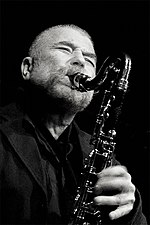
Free jazz and the related form of avant-garde jazz, are subgenres rooted in bebop, that use less compositional material and allow performers more latitude. Free jazz uses implied or loose harmony and tempo, which was deemed controversial when this approach was first developed. The bassist Charles Mingus is also frequently associated with the avant-garde in jazz, although his compositions draw off a myriad of styles and genres. The first major stirrings came in the 1950s, with the early work of Ornette Coleman and Cecil Taylor. In the 1960s, performers included John Coltrane, Archie Shepp, Sun Ra, Pharoah Sanders, and others. Keith Jarrett has been prominent in defending free jazz from criticism by traditionalists in recent years.
1960s and 1970s
Latin jazz
Latin jazz has two main varieties: Afro-Cuban and Brazilian jazz. Afro-Cuban jazz was played in the U.S. directly after the bebop period, while Brazilian jazz became more popular in the 1960s. Afro-Cuban jazz began as a movement in the mid-1950s as bebop musicians such as Dizzy Gillespie and Billy Taylor started Afro-Cuban bands influenced by such Cuban and Puerto Rican musicians as Xavier Cugat, Tito Puente, and Arturo Sandoval. Brazilian jazz such as bossa nova is derived from samba, with influences from jazz and other 20th century classical and popular music styles. Bossa is generally moderately paced, with melodies sung in Portuguese or English. The style was pioneered by Brazilians João Gilberto, Antônio Carlos Jobim. The related term jazz-samba describes an adaptation of bossa nova compositions to the jazz idiom by American performers such as Stan Getz and Charlie Byrd.
Soul Jazz
Soul jazz was a development of hard bop which incorporated strong influences from blues, gospel and rhythm and blues in music for small groups, often the organ trio which featured the Hammond organ. Unlike hard bop, soul jazz generally emphasized repetitive grooves and melodic hooks, and improvisations were often less complex than in other jazz styles. Horace Silver had a large influence on the soul jazz style, with his songs that used funky and often gospel-based piano vamps. Important soul jazz organists included Jimmy McGriff and Jimmy Smith and Johnny Hammond Smith, and influential tenor saxophone players included Eddie "Lockjaw" Davis and Stanley Turrentine. (See also List of soul-jazz musicians.)
Jazz fusion
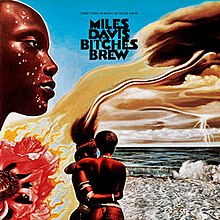
In the late 1960s and early 1970s the hybrid form of jazz-rock fusion was developed. Although jazz purists protested the blend of jazz and rock, some of jazz' significant innovators crossed over from the contemporary hardbop scene into fusion. Jazz fusion music often uses mixed meters, odd time signatures, syncopation, and complex chords and harmonies, and fusion includes a number of electric instruments, such as the electric guitar, electric bass, electric piano, and synthesizer keyboards. Notable performers of jazz fusion included Miles Davis, keyboardists Chick Corea and Herbie Hancock, drummer Tony Williams, guitarists Larry Coryell and John McLaughlin, Frank Zappa, saxophonist Wayne Shorter, and bassist-composer Jaco Pastorius.
1970s trends
There was a resurgence in interest in jazz and other forms of African American cultural expression during the Black Arts Movement and Black nationalist period of the early 1970s. Musicians such as Pharaoh Sanders, Hubert Laws and Wayne Shorter began using kalimbas, cowbells, beaded gourds and other instruments not traditional to jazz. Alice Coltrane drew notice as a jazz harpist, Jean-Luc Ponty as a jazz violinist, and Rufus Harley as a bagpipe player. Jazz continued to expand and change, influenced by other types of music, such as world music, avant garde classical music, and rock and pop music. Guitarist John McLaughlin's Mahavishnu Orchestra played a mix of rock and jazz infused with East Indian influences. The ECM record label began in the 1970s with artists including Keith Jarrett, Paul Bley, the Pat Metheny Group, Jan Garbarek, Ralph Towner, and Eberhard Weber, establishing a new chamber-music aesthetic, featuring mainly acoustic instruments, and incorporating elements of world music and folk music.
1980s-2000s
In the 1980s, the jazz community shrank dramatically and split. A mainly older audience retained an interest in traditional and "straight-ahead" jazz styles. Wynton Marsalis strove to create music within what he believed was the tradition, creating extensions of small and large forms initially pioneered by such artists as Louis Armstrong and Duke Ellington.
In the early 1980s, a lighter commercial form of jazz fusion called pop fusion or "smooth jazz" became successful and garnered significant radio airplay. Smooth jazz saxophonists include Grover Washington, Jr., Kenny G and Najee. Smooth jazz received frequent airplay with more straight-ahead jazz in quiet storm time slots at radio stations in urban markets across the U.S., helping to establish or bolster the careers of vocalists including Al Jarreau, Anita Baker, Chaka Khan, and Sade.
In the late 1980s and early 1990s, several subgenres fused jazz with popular music, such as Acid jazz, nu jazz, and jazz rap. Acid jazz and nu jazz combined elements of jazz and modern forms of electronic dance music. While nu jazz is influenced by jazz harmony and melodies, there are usually no improvisational aspects. Jazz rap fused jazz and hip-hop. Rapper Gang Starr recorded a single "Words I Manifest" which sampled Miles Davis). In 1993, Rapper Guru'sJazzmatazz series used jazz musicians during the studio recordings.
The more experimental and improvisational end of the spectrum includes pianist Bugge Wesseltoft and Christian McBride in the US. Toward the more pop or dance music end of the spectrum are St Germain who incorporates some live jazz playing with house beats. Radiohead, Björk, and Portishead have also incorporated jazz influences into their music.
In the 2000s, straight-ahead jazz continues to appeal to a core of listeners. Well-established jazz musicians whose careers span decades, such as Jack DeJohnette, Bill Frisell, Wynton Marsalis, John McLaughlin, Pat Metheny, Paquito D'Rivera, Herbie Hancock, Sonny Rollins, John Scofield, Wayne Shorter, John Surman, Stan Tracey and Jessica Williams continue to perform and record.
Definitional concerns
As the term "jazz" has long been used for a wide variety of styles, a comprehensive definition including all varieties is elusive. While some enthusiasts of certain types of jazz have argued for narrower definitions which exclude many other types of music also commonly known as "jazz", jazz musicians themselves are often reluctant to define the music they play. Duke Ellington summed it up by saying, "It's all music." Some critics have even stated that Ellington's music was not in fact jazz, as by its very definition, according to them, jazz cannot be orchestrated. On the other hand Ellington's friend Earl Hines' s 20 solo "transformative versions" of Ellington compositions (on Earl Hines Plays Duke Ellington recorded in the 1970s) were described by Ben Ratliff, the New York Times jazz critic, as "as good an example of the jazz process as anything out there."[26]
There have long been debates in the jazz community over the definition and the boundaries of “jazz.” In the mid-1930s, New Orleans jazz lovers criticized the "innovations" of the swing era as being contrary to the collective improvisation they saw as essential to "true" jazz. Thru the 1940s, '50s and '60s, traditional jazz enthusiasts and Bop enthusiasts criticized each other, often arguing that the other style was somehow not "real" jazz. Although alteration or transformation of jazz by new influences has often been initially criticized as a “debasement,” Andrew Gilbert argues that jazz has the “ability to absorb and transform influences” from diverse musical styles[27].
Commercially-oriented or 'popular' music-influenced forms of jazz have both long been criticized, at least since the emergence of Bop. Traditional jazz enthusiasts have dismissed Bop, the 1970s jazz fusion era [and much else] as a period of commercial debasement of the music. However, according to Bruce Johnson, jazz music has always had a "tension between jazz as a commercial music and an art form" [28].
Gilbert notes that as the notion of a canon of jazz is developing, the “achievements of the past” may be become "…privileged over the idiosyncratic creativity...” and innovation of current artists. Village Voice jazz critic Gary Giddins argues that as the creation and dissemination of jazz is becoming increasingly institutionalized and dominated by major entertainment firms, jazz is facing a "...perilous future of respectability and disinterested acceptance." David Ake warns that the creation of “norms” in jazz and the establishment of a “jazz tradition” may exclude or sideline other newer, avant-garde forms of jazz[28].
One way to get around the definitional problems is to define the term “jazz” more broadly. According to Krin Gabbard “jazz is a construct” or category that, while artificial, still is useful to designate “a number of musics with enough in common part of a coherent tradition”. Travis Jackson also defines jazz in a broader way by stating that it is music that includes qualities such as “ 'swinging', improvising, group interaction, developing an 'individual voice', and being 'open' to different musical possibilities”[28].
Improvisation

While jazz may be difficult to define, improvisation is clearly one of its key elements.
Early blues was commonly structured around a repetitive call-and-response pattern, a common element in the African American oral tradition. A form of folk music which rose in part from work songs and field hollers of rural Blacks, early blues was also highly improvisational. These features are fundamental to the nature of jazz. While in European classical music elements of interpretation, ornamentation and accompaniment are sometimes left to the performer's discretion, the performer's primary goal is to play a composition as it was written.
In jazz, however, the skilled performer will interpret a tune in very individual ways, never playing the same composition exactly the same way twice. Depending upon the performer's mood and personal experience, interactions with fellow musicians, or even members of the audience, a jazz musician/performer may alter melodies, harmonies or time signature at will. European classical music has been said to be a composer's medium. Jazz, however, is often characterized as the product of democratic creativity, interaction and collaboration, placing equal value on the contributions of composer and performer, 'adroitly weigh[ing] the respective claims of the composer and the improviser'.[29]
In New Orleans and Dixieland jazz, performers took turns playing the melody, while others improvised countermelodies. By the swing era, big bands were coming to rely more on arranged music: arrangements were either written or learned by ear and memorized - many early jazz performers could not read music. Individual soloists would improvise within these arrangements. Later, in bebop the focus shifted back towards small groups and minimal arrangements; the melody (known as the "head") would be stated briefly at the start and end of a piece but the core of the performance would be the series of improvisations in the middle.
Later styles of jazz such as modal jazz abandoned the strict notion of a chord progression, allowing the individual musicians to improvise even more freely within the context of a given scale or mode.[30] The avant-garde and free jazz idioms permit, even call for, abandoning chords, scales, and rhythmic meters.
See also
Template:Sample box start Template:Multi-listen start Template:Multi-listen item Template:Multi-listen item Template:Multi-listen item Template:Multi-listen item Template:Multi-listen item Template:Multi-listen item Template:Multi-listen end Template:Sample box end
- Alabama Jazz Hall of Fame
- American Jazz Museum
- Big Band and Jazz Hall of Fame
- Cape Jazz
- Cool (aesthetic)
- European free jazz
- International Association for Jazz Education
- Jazz albums, list of
- Jazz at Lincoln Center
- Jazz clubs, list of
- Jazz festivals, list of
- Jazz institutions and organizations, list of
- Jazz musicians, list of
- Jazz pieces, list of
- Jazz poetry
- Jazz standard
- Jazz (word)
- Jazzpar Prize
- Music of the United States
- Swing (genre)
- Thirty-two-bar form
Sources
- Allen, William Francis, Charles Pickard Ware, and Lucy McLim Garrison, eds. 1867. Slave Songs of the United States. New York: A Simpson & Co. Electronic edition, Chapel Hill, N. C.: Academic Affairs Library, University of North Carolina at Chapel Hill, 2000.
- Burns, Ken, and Geoffrey C. Ward. 2000. Jazz—A History of America's Music. New York: Alfred A. Knopf. Also: The Jazz Film Project, Inc.
- Cooke, Mervyn (1999), Jazz, London: Thames and Hudson, ISBN 0-500-20318-0.
- Davis, Miles. 2005. Miles Davis (2005). Boplicity. ISBN 4-006408-264637.
{{cite AV media}}: Unknown parameter|Label=ignored (help) - Elsdon, Peter. 2003. "The Cambridge Companion to Jazz, Edited by Mervyn Cooke and David Horn, Cambridge: Cambridge University Press, 2002. Review." Frankfürter Zeitschrift für Musikwissenschaft 6:159–75.
- Gang Starr. 2006. Mass Appeal: The Best of Gang Starr. CD recording 72435-96708-2-9. New York: Virgin Records.
- Giddins, Gary. 1998. Visions of Jazz: The First Century New York: Oxford University Press. ISBN 0195076753
- Gridley, Mark C. 2004. Concise Guide to Jazz, fourth edition. Upper Saddle River, NJ: Pearson/Prentice Hall. ISBN 0131826573
- Kenney, William Howland. 1993. Chicago Jazz: A Cultural History, 1904-1930. New York: Oxford University Press. ISBN 0195064534 (cloth); paperback reprint 1994 ISBN 0195092600
- Oliver, Paul (1970), Savannah Syncopators: African Retentions in the Blues, London: Studio Vista, ISBN 0-289-79827-2.
- Mandel, Howard. 2007. Miles, Ornette, Cecil: Jazz Beyond Jazz. Routledge. ISBN 0415967147.
- Porter, Eric. What Is This Thing Called Jazz? African American Musicians as Artists, Critics and Activists. University of California Press, Ltd. London, England. 2002.
- Ratliffe, Ben. 2002. Jazz: A Critic's Guide to the 100 Most Important Recordings. The New York Times Essential Library. New York: Times Books. ISBN 0805070680
- Scaruffi, Piero: A History of Jazz Music 1900-2000 (Omniware, 2007)
- Szwed, John Francis. 2000. Jazz 101: A Complete Guide to Learning and Loving Jazz. New York: Hyperion. ISBN 0786884967
References
- ^ "Understanding Jazz: The Roots of Jazz". Retrieved 2007-10-23.
- ^ "6. Microtiming Studies". Retrieved 2007-10-23.
- ^ Cooke 1999, p. 7-9
- ^ Cooke 1999, p. 11-14
- ^ Cooke 1999, p. 14-17, 27-28
- ^ Cooke 1999, p. 18
- ^ Cooke 1999, p. 28, 47
- ^ Catherine Schmidt-Jones (2006). "Ragtime". Connexions. Retrieved 2007-10-18.
- ^ Cooke 1999, p. 18
- ^ Cooke 1999, p. 47, 50
- ^ "The Influence of African Rhythms""North by South, from Charleston to Harlem," a project of the National Endowment for the Humanities Retrieved 10-29-2004
- ^ "Original Creole Orchestra". The Red Hot Archive. Retrieved 2007-10-23.
- ^ Cooke 1999, p. 38, 56
- ^ Cooke 1999, p. 78
- ^ a b Floyd Levin. "Jim Europe's 369th Infantry "Hellfighters" Band". The Red Hot Archive. Retrieved 2007-10-24.
- ^ Cooke 1999, p. 41-42
- ^ "Tim Gracyk's Phonographs, Singers, and Old Records – Jass in 1916-1917 and Tin Pan Alley". Retrieved 2007-10-27.
- ^ Cooke 1999, p. 52
- ^ "The First Jazz Records". The Red Hot Archive. Retrieved 2007-10-27.
- ^ Cooke 1999, p. 44
- ^ Cooke 1999, p. 54
- ^ "Kid Ory". The Red Hot Archive. Retrieved 2007-10-29.
- ^ "Bessie Smith". The Red Hot Archive. Retrieved 2007-10-29.
- ^ Cooke 1999, p. 56-59, 78-79, 66-70
- ^ Cooke 1999, p. 82-83, 100-103
- ^ Ratliff 2002, 19.
- ^ In "Jazz Inc." by Andrew Gilbert, Metro Times, December 23 1998
- ^ a b c In Review of The Cambridge Companion to Jazz by Peter Elsdon, FZMw (Frankfurt Journal of Musicology) No. 6, 2003
- ^ Giddins 1998, 70.
- ^ (e.g., "So What" on the Miles Davis album Kind of Blue)
External links
- Online jazz radio stations
- Great Jazz Musician Biographies
- Jazz History Timeline
- Jazz - A Film by Ken Burns, PBS
- Jazz @ the Smithsonian
- Smooth Jazz Radio Links
- Piero Scaruffi's history of jazz music 1900-2000
- Alabama Jazz Hall of Fame website
- Jazz at Lincoln Center website
- American Jazz Museum website
- Europe Jazz Network
